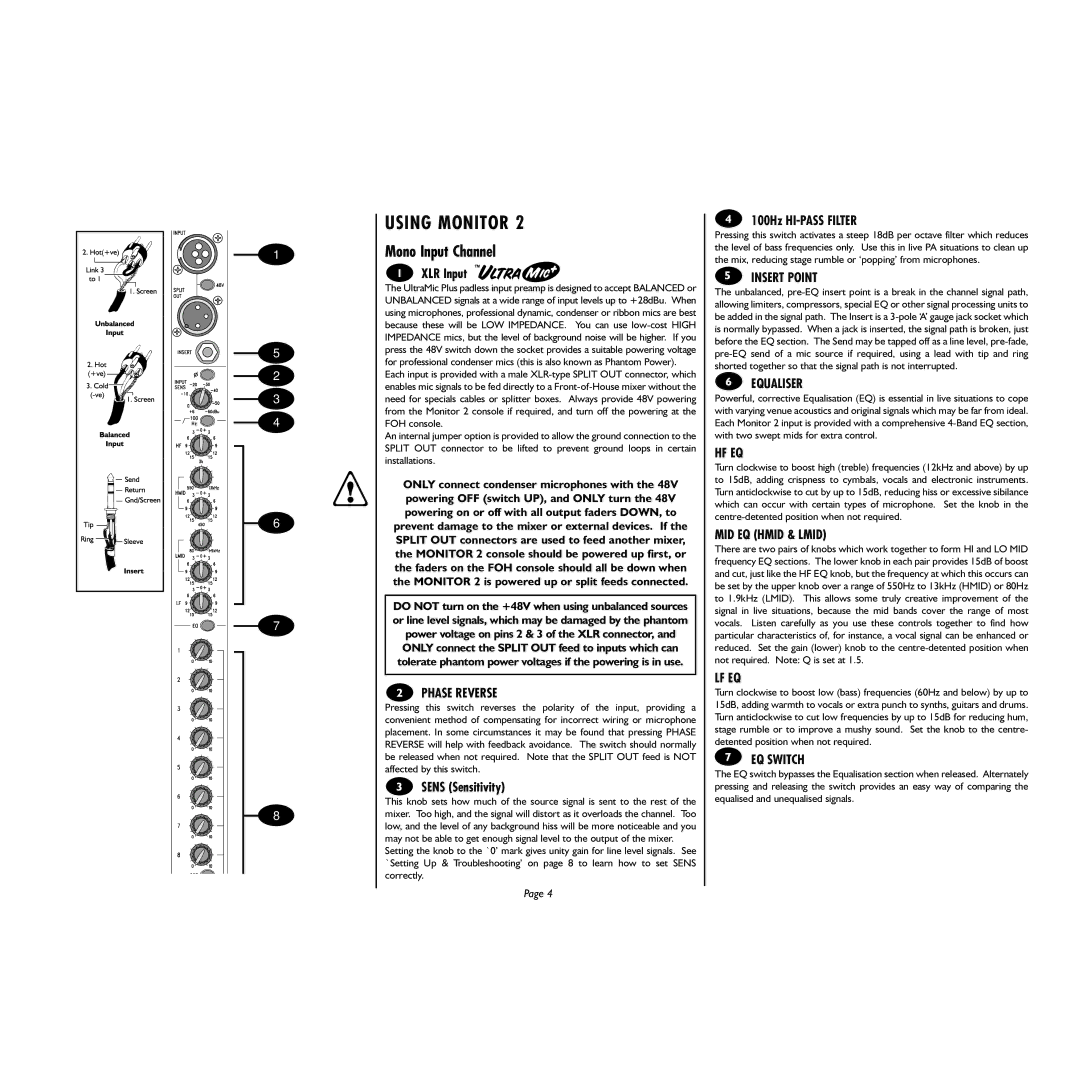
1
5
2
3
4
6
7
8
USING MONITOR 2
Mono Input Channel
XLR Input
The UltraMic Plus padless input preamp is designed to accept BALANCED or UNBALANCED signals at a wide range of input levels up to +28dBu. When using microphones, professional dynamic, condenser or ribbon mics are best because these will be LOW IMPEDANCE. You can use
Each input is provided with a male
An internal jumper option is provided to allow the ground connection to the SPLIT OUT connector to be lifted to prevent ground loops in certain installations.
ONLY connect condenser microphones with the 48V powering OFF (switch UP), and ONLY turn the 48V powering on or off with all output faders DOWN, to prevent damage to the mixer or external devices. If the SPLIT OUT connectors are used to feed another mixer, the MONITOR 2 console should be powered up first, or the faders on the FOH console should all be down when the MONITOR 2 is powered up or split feeds connected.
DO NOT turn on the +48V when using unbalanced sources or line level signals, which may be damaged by the phantom power voltage on pins 2 & 3 of the XLR connector, and ONLY connect the SPLIT OUT feed to inputs which can tolerate phantom power voltages if the powering is in use.
PHASE REVERSE
Pressing this switch reverses the polarity of the input, providing a convenient method of compensating for incorrect wiring or microphone placement. In some circumstances it may be found that pressing PHASE REVERSE will help with feedback avoidance. The switch should normally be released when not required. Note that the SPLIT OUT feed is NOT affected by this switch.
SENS (Sensitivity)
This knob sets how much of the source signal is sent to the rest of the mixer. Too high, and the signal will distort as it overloads the channel. Too low, and the level of any background hiss will be more noticeable and you may not be able to get enough signal level to the output of the mixer.
Setting the knob to the `0’ mark gives unity gain for line level signals. See `Setting Up & Troubleshooting’ on page 8 to learn how to set SENS correctly.
Page 4
100Hz HI-PASS FILTER
Pressing this switch activates a steep 18dB per octave filter which reduces the level of bass frequencies only. Use this in live PA situations to clean up the mix, reducing stage rumble or ‘popping’ from microphones.
INSERT POINT
The unbalanced,
EQUALISER
Powerful, corrective Equalisation (EQ) is essential in live situations to cope with varying venue acoustics and original signals which may be far from ideal. Each Monitor 2 input is provided with a comprehensive
HF EQ
Turn clockwise to boost high (treble) frequencies (12kHz and above) by up to 15dB, adding crispness to cymbals, vocals and electronic instruments. Turn anticlockwise to cut by up to 15dB, reducing hiss or excessive sibilance which can occur with certain types of microphone. Set the knob in the
MID EQ (HMID & LMID)
There are two pairs of knobs which work together to form HI and LO MID frequency EQ sections. The lower knob in each pair provides 15dB of boost and cut, just like the HF EQ knob, but the frequency at which this occurs can be set by the upper knob over a range of 550Hz to 13kHz (HMID) or 80Hz to 1.9kHz (LMID). This allows some truly creative improvement of the signal in live situations, because the mid bands cover the range of most vocals. Listen carefully as you use these controls together to find how particular characteristics of, for instance, a vocal signal can be enhanced or reduced. Set the gain (lower) knob to the
LF EQ
Turn clockwise to boost low (bass) frequencies (60Hz and below) by up to 15dB, adding warmth to vocals or extra punch to synths, guitars and drums. Turn anticlockwise to cut low frequencies by up to 15dB for reducing hum, stage rumble or to improve a mushy sound. Set the knob to the centre- detented position when not required.
EQ SWITCH
The EQ switch bypasses the Equalisation section when released. Alternately pressing and releasing the switch provides an easy way of comparing the equalised and unequalised signals.
